Influence of Surface Water on Desert Vegetation Expansion at the Landscape Scale: A Case Study of the Daliyabuyi Oasis, Taklamakan Desert
Abstract
:1. Introduction
2. Study Site and Data
2.1. Study Site
2.2. Data
2.2.1. Landsat Images
2.2.2. Unmanned Aerial Vehicle (UAV) Images
2.2.3. Soil Nutrient Content Data
3. Methods
3.1. Identification of Vegetation
3.1.1. NDVI Calculation
3.1.2. Using the MVC Method to Synthesize the Annual NDVI
3.1.3. Extracting the Vegetation Distribution
3.2. Mapping Surface Water Distribution
3.2.1. Water Index
3.2.2. Automatic Threshold Determination Method
3.3. Accuracy of Surface Water Extraction
3.4. Relative Frequency of Surface Water Distribution
4. Results
4.1. Temporal and Spatial Distribution of Vegetation and Surface Water
4.2. Effects of Surface Water on Vegetation Expansion
4.2.1. Landform Changes
- Sediment deposition
- 2.
- Erosion of sand dunes by surface water
- Sand dune cut-off
- b.
- Flattening of low dunes
4.2.2. Analysis of Plant Seedling Colonization Process
4.3. Soil Nutrient Analysis
5. Discussion
6. Conclusions
- Changing the landform near the river channel, the surface water drives the transformation of the dune near the river to the floodplain, providing a potential colonization site for plant seedlings;
- Surface water indirectly affects water redistribution by changing the landform. The formation of the floodplain ensures the accessibility of surface water and provides a relatively stable water supply for vegetation growth;
- Surface water provides soil nutrients for the floodplain; thus, the river sediments are rich in soil nutrients, such as organic matter, nitrogen, and phosphorus, and are the main sources of soil nutrients in the floodplain.
Supplementary Materials
Author Contributions
Funding
Institutional Review Board Statement
Informed Consent Statement
Data Availability Statement
Conflicts of Interest
References
- Ding, C.; Huang, W.; Li, Y.; Zhao, S.; Huang, F. Nonlinear Changes in Dryland Vegetation Greenness over East Inner Mongolia, China, in Recent Years from Satellite Time Series. Sensors 2020, 20, 3839. [Google Scholar] [CrossRef]
- Yang, X. The oases along the Keriya River in the Taklamakan Desert, China, and their evolution since the end of the last glaciation. Environ. Geol. 2001, 41, 314–320. [Google Scholar] [CrossRef]
- Venter, Z.S.; Scott, S.L.; Desmet, P.G.; Hoffman, M.T. Application of Landsat-derived vegetation trends over South Africa: Potential for monitoring land degradation and restoration. Ecol. Indic. 2020, 113, 106206. [Google Scholar] [CrossRef]
- Srivastava, A.; Saco, P.M.; Rodriguez, J.F.; Kumari, N.; Chun, K.P.; Yetemen, O. The role of landscape morphology on soil moisture variability in semi-arid ecosystems. Hydrol. Process. 2021, 35, 13990. [Google Scholar] [CrossRef]
- Maza, M.; Srivastava, A.; Bisht, D.S.; Raghuwanshi, N.S.; Bandyopadhyay, A.; Chatterjee, C.; Bhadra, A. Simulating hydrological response of a monsoon dominated reservoir catchment and command with heterogeneous cropping pattern using VIC model. J. Earth Syst. Sci. 2020, 129, 200. [Google Scholar] [CrossRef]
- Hutchins, R.B.; Blevins, R.L.; Hill, J.D.; White, E.H. The influence of soils and microclimate on vegetation of forested slopes in eastern kentucky. Soil Sci. 1976, 121, 234–241. [Google Scholar] [CrossRef]
- Florinsky, I.; Kuryakova, G. Influence of topography on some vegetation cover properties. Catena 1996, 27, 123–141. [Google Scholar] [CrossRef]
- Yetemen, O.; Istanbulluoglu, E.; Flores-Cervantes, J.H.; Vivoni, E.R.; Bras, R.L. Ecohydrologic role of solar radiation on landscape evolution. Water Resour. Res. 2015, 51, 1127–1157. [Google Scholar] [CrossRef]
- Kumari, N.; Srivastava, A.; Dumka, U.C. A Long-Term Spatiotemporal Analysis of Vegetation Greenness over the Himalayan Region Using Google Earth Engine. Climate 2021, 9, 109. [Google Scholar] [CrossRef]
- Shaw, J.R.; Cooper, D.J. Linkages among watersheds, stream reaches, and riparian vegetation in dryland ephemeral stream networks. J. Hydrol. 2008, 350, 68–82. [Google Scholar] [CrossRef]
- Vesipa, R.; Camporeale, C.; Ridolfi, L. Effect of river flow fluctuations on riparian vegetation dynamics: Processes and models. Adv. Water Resour. 2017, 110, 29–50. [Google Scholar] [CrossRef] [Green Version]
- Guo, H.; Jiapaer, G.; Bao, A.; Li, X.; Huang, Y.; Ndayisaba, F.; Meng, F. Effects of the Tarim River’s middle stream water transport dike on the fractional cover of desert riparian vegetation. Ecol. Eng. 2017, 99, 333–342. [Google Scholar] [CrossRef]
- Xu, M.; Chen, Y.; Liu, J.; Wang, D.; Liu, Y. The distribution pattern dynamics of Populus euphratica are influenced by hydrology in the middle reaches of Tarim River. Acta Ecol. Sin. 2016, 36, 2646–2655. [Google Scholar]
- Webb, R.H.; Leake, S.A. Ground-water surface-water interactions and long-term change in riverine riparian vegetation in the southwestern United States. J. Hydrol. 2006, 320, 302–323. [Google Scholar] [CrossRef]
- Shafroth, P.B.; Schlatter, K.J.; Gomez-Sapiens, M.; Lundgren, E.; Grabau, M.R.; Ramírez-Hernández, J.; Rodríguez-Burgueño, J.E.; Flessa, K.W. A large-scale environmental flow experiment for riparian restoration in the Colorado River Delta. Ecol. Eng. 2017, 106, 645–660. [Google Scholar] [CrossRef]
- Schlatter, K.J.; Grabau, M.R.; Shafroth, P.B.; Zamora-Arroyo, F. Integrating active restoration with environmental flows to improve native riparian tree establishment in the Colorado River Delta. Ecol. Eng. 2017, 106, 661–674. [Google Scholar] [CrossRef]
- Chen, Y.; Pang, Z.; Chen, Y.; Li, W.; Xu, C.; Hao, X.; Huang, X.; Huang, T.; Ye, Z. Response of riparian vegetation to water-table changes in the lower reaches of Tarim River, Xinjiang Uygur, China. Hydrogeol. J. 2008, 16, 1371–1379. [Google Scholar] [CrossRef]
- Chen, Y.; Li, W.; Chen, Y.; Zhou, H.; Hao, X.; Zhu, C. Water Use Process of Constructive Plants in Desert Riparian Forest. Arid Zone Res. 2018, 35, 130–136. [Google Scholar] [CrossRef]
- Zheng, Y.; Jiao, P.; Zhao, Z.; Li, Z. Clonal growth of Populus Pruinosa Schrenk and its role in the regeneration of riparian forests. Ecol. Eng. 2016, 94, 380–392. [Google Scholar] [CrossRef]
- Halik, Ü.; Aishan, T.; Betz, F.; Kurban, A.; Rouzi, A. Effectiveness and challenges of ecological engineering for desert riparian forest restoration along China’s largest inland river. Ecol. Eng. 2019, 127, 11–22. [Google Scholar] [CrossRef]
- Liu, G.; Kurban, A.; Duan, H.; Halik, Ü.; Ablekim, A.; Zhang, L. Desert riparian forest colonization in the lower reaches of Tarim River based on remote sensing analysis. Environ. Earth Sci. 2014, 71, 4579–4589. [Google Scholar] [CrossRef]
- Bornette, G.; Tabacchi, E.; Hupp, C.; Puijalon, S.; Rostan, J.C. A model of plant strategies in fluvial hydrosystems. Freshw. Biol. 2008, 53, 1692–1705. [Google Scholar] [CrossRef] [Green Version]
- Stromberg, J.C.; Tluczek, M.G.F.; Hazelton, A.F.; Ajami, H. A century of riparian forest expansion following extreme disturbance: Spatio-temporal change in Populus/Salix/Tamarix forests along the Upper San Pedro River, Arizona, USA. For. Ecol. Manag. 2010, 259, 1181–1189. [Google Scholar] [CrossRef]
- Lytle, D.A.; Merritt, D.M. Hydrologic regimes and riparian forests: A structured population model for cottonwood. Ecology 2004, 85, 2493–2503. [Google Scholar] [CrossRef] [Green Version]
- Cao, D.; Li, J.; Huang, Z.; Baskin, C.C.; Baskin, J.M.; Hao, P.; Zhou, W.; Li, J. Reproductive Characteristics of a Populus euphratica Population and Prospects for Its Restoration in China. PLoS ONE 2012, 7, e39121. [Google Scholar] [CrossRef] [Green Version]
- Hopley, T.; Byrne, M. Connectivity in riparian plants: Influence of vegetation type and habitat fragmentation overrides water flow. Oecologia 2018, 188, 465–478. [Google Scholar] [CrossRef] [PubMed]
- Jarchow, C.J.; Nagler, P.L.; Glenn, E.P. Greenup and evapotranspiration following the Minute 319 pulse flow to Mexico: An analysis using Landsat 8 Normalized Difference Vegetation Index (NDVI) data. Ecol. Eng. 2017, 106, 776–783. [Google Scholar] [CrossRef]
- Hill, M. Vegetation index suites as indicators of vegetation state in grassland and savanna: An analysis with simulated SENTINEL 2 data for a North American transect. Remote Sens. Environ. 2013, 137, 94–111. [Google Scholar] [CrossRef]
- Walker, J.J.; Soulard, C.E.; Petrakis, R.E. Integrating stream gage data and Landsat imagery to complete time-series of surface water extents in Central Valley, California. Int. J. Appl. Earth Obs. Geoinform. 2020, 84, 101973. [Google Scholar] [CrossRef]
- Dube, T.; Mutanga, O. Evaluating the utility of the medium-spatial resolution Landsat 8 multispectral sensor in quantifying aboveground biomass in uMgeni catchment, South Africa. ISPRS J. Photogramm. Remote Sens. 2015, 101, 36–46. [Google Scholar] [CrossRef]
- Seaton, D.; Dube, T.; Mazvimavi, D. Use of multi-temporal satellite data for monitoring pool surface areas occurring in non-perennial rivers in semi-arid environments of the Western Cape, South Africa. ISPRS J. Photogramm. Remote Sens. 2020, 167, 375–384. [Google Scholar] [CrossRef]
- Rouse, J.; Haas, R.; Schell, J.; Deering, D.; Harlan, J. Monitoring the Vernal Advancement and Retrogradation (Green Wave Effect) of Natural Vegetation; Final Report; NASA/GSFC Type III: Greenbelt, MD, USA, 1974. [Google Scholar]
- Tucker, C.J. Red and photographic infrared linear combinations for monitoring vegetation. Remote Sens. Environ. 1979, 8, 127–150. [Google Scholar] [CrossRef] [Green Version]
- Kumari, N.; Saco, P.M.; Rodriguez, J.F.; Johnstone, S.A.; Srivastava, A.; Chun, K.P.; Yetemen, O. The Grass Is Not Always Greener on the Other Side: Seasonal Reversal of Vegetation Greenness in Aspect-Driven Semiarid Ecosystems. Geophys. Res. Lett. 2020, 47, e2020GL088918. [Google Scholar] [CrossRef]
- Otsu, N. A Threshold Selection Method from Gray-Level Histograms. IEEE Trans. Syst. Man Cybern. 1979, 9, 62–66. [Google Scholar] [CrossRef] [Green Version]
- Feyisa, G.L.; Meilby, H.; Fensholt, R.; Proud, S. Automated Water Extraction Index: A new technique for surface water mapping using Landsat imagery. Remote Sens. Environ. 2014, 140, 23–35. [Google Scholar] [CrossRef]
- Kapur, J.N.; Sahoo, P.K.; Wong, A.K.C. A new method for gray-level picture thresholding using the entropy of the histogram. Comput. Vision Graph. Image Process. 1985, 29, 273–285. [Google Scholar] [CrossRef]
- Shi, H.; Shi, Q.; Zhou, X.; Imin, B.; Li, H.; Zhang, W.; Kahaer, Y. Effect of the competition mechanism of between co-dominant species on the ecological characteristics of Populus euphratica under a water gradient in a desert oasis. Glob. Ecol. Conserv. 2021, 27, e01611. [Google Scholar] [CrossRef]
- Hao, L.; Qingdong, S.; Imin, B.; Kasim, N. Methodology for optimizing quadrat size in sparse vegetation surveys: A desert case study from the Tarim Basin. PLoS ONE 2020, 15, e0235469. [Google Scholar] [CrossRef]
- Shi, Q.; Guo, Y.; Zhou, X. Machanism of the influence of surface water and groundw-ater on vegetation pattern in Daliyaboyi oasis at the tail of Keriya river in Taklamakan deser. J. Xin-Jiang Univ. (Nat. Sci. Ed.) 2019, 36, 253–259. [Google Scholar] [CrossRef]
- Li, H.; Shi, Q.; Wan, Y.; Shi, H.; Imin, B. Using Sentinel-2 Images to Map the Populus euphratica Distribution Based on the Spectral Difference Acquired at the Key Phenological Stage. Forests 2021, 12, 147. [Google Scholar] [CrossRef]
- Tulbure, M.G.; Broich, M.; Stehman, S.V.; Kommareddy, A. Surface water extent dynamics from three decades of seasonally continuous Landsat time series at subcontinental scale in a semi-arid region. Remote Sens. Environ. 2016, 178, 142–157. [Google Scholar] [CrossRef]
- Ni, P. History, Present Situation and Evolution Prospect of Daliyaboyi oasis. Arid Zone Res. 1993, 10, 12–18. [Google Scholar]
- Zhu, Z.; Lu, J.; Jiang, W. Study on Formation and Development of Aeolian Landform and Trend of Environment Change at Lower reach of Keriya River, Taklimakan Desert. J. Desert Res. 1988, 8, 1–10. [Google Scholar]
- Dong, Z.; Lyu, P. Development of aeolian geomorphology in China in the past 70years. Acta Geogr. Sin. 2020, 75, 509–528. [Google Scholar] [CrossRef]
- Junk, W.J.; Bayley, P.; Sparks, R. The Flood Pulse Concept in River-Floodplain Systems. Can. Spec. Publ. Fish. Aquat. Sci. 1989, 106, 110–127. [Google Scholar]
- Perona, P.; Camporeale, C.; Perucca, E.; Savina, M.; Molnar, P.; Burlando, P.; Ridolfi, L. Modelling river and riparian vegetation interactions and related importance for sustainable ecosystem management. Aquat. Sci. 2009, 71, 266–278. [Google Scholar] [CrossRef] [Green Version]
- Poff, N.L.; Allan, J.D.; Bain, M.B.; Karr, J.R.; Prestegaard, K.L.; Richter, B.D.; Sparks, R.E.; Stromberg, J.C. The Natural Flow Regime. Bioscience 1997, 47, 769–784. [Google Scholar] [CrossRef]
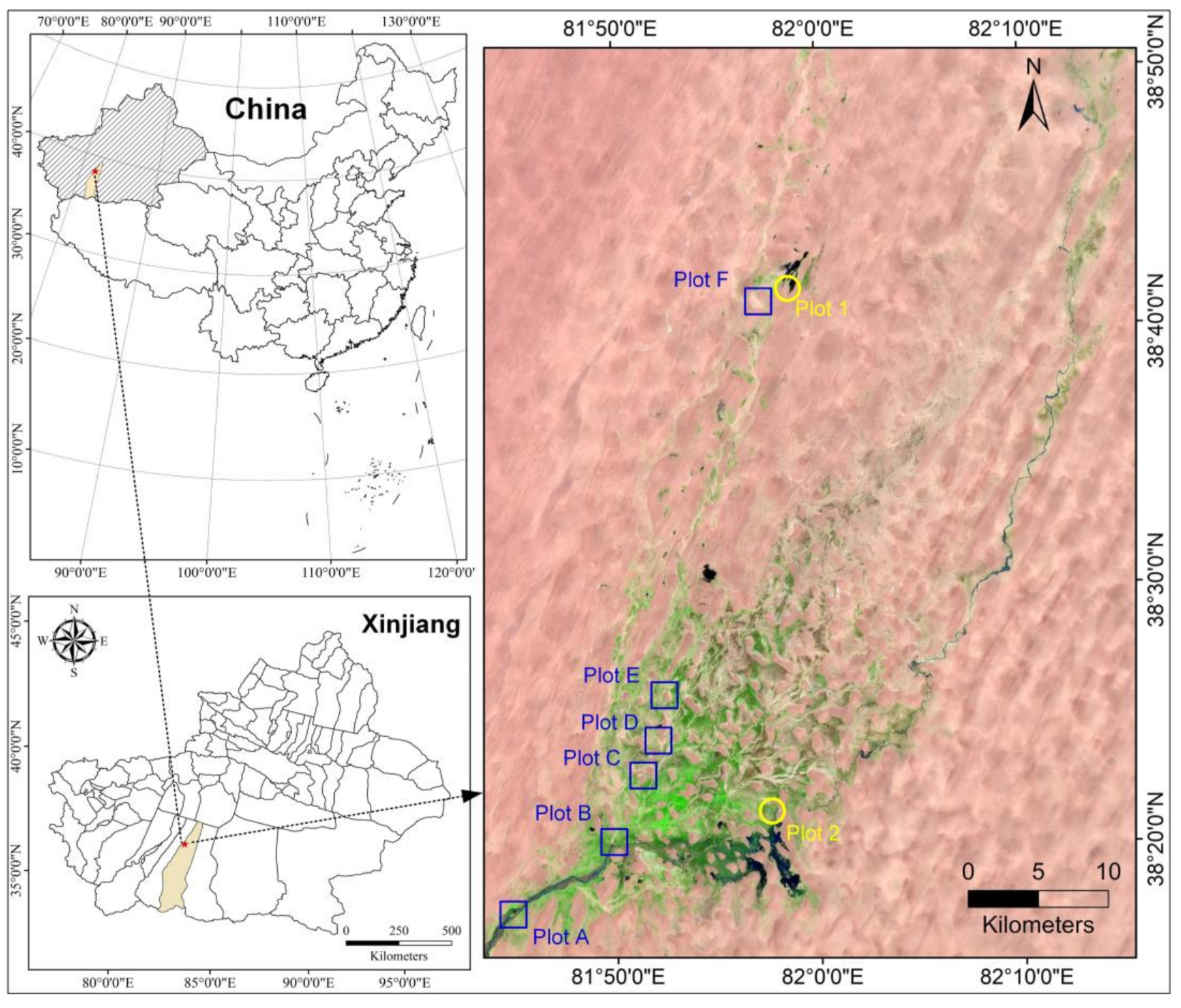

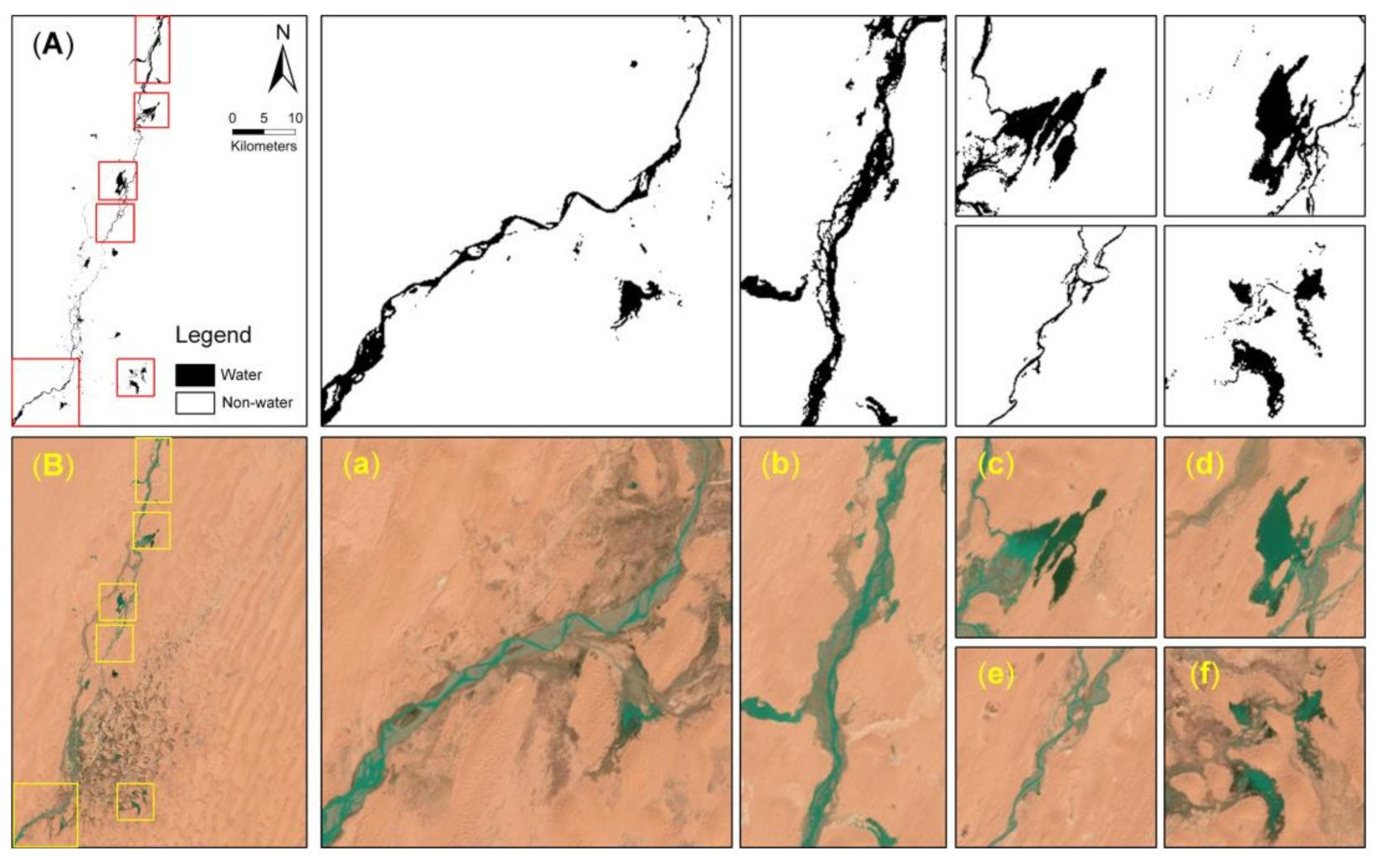

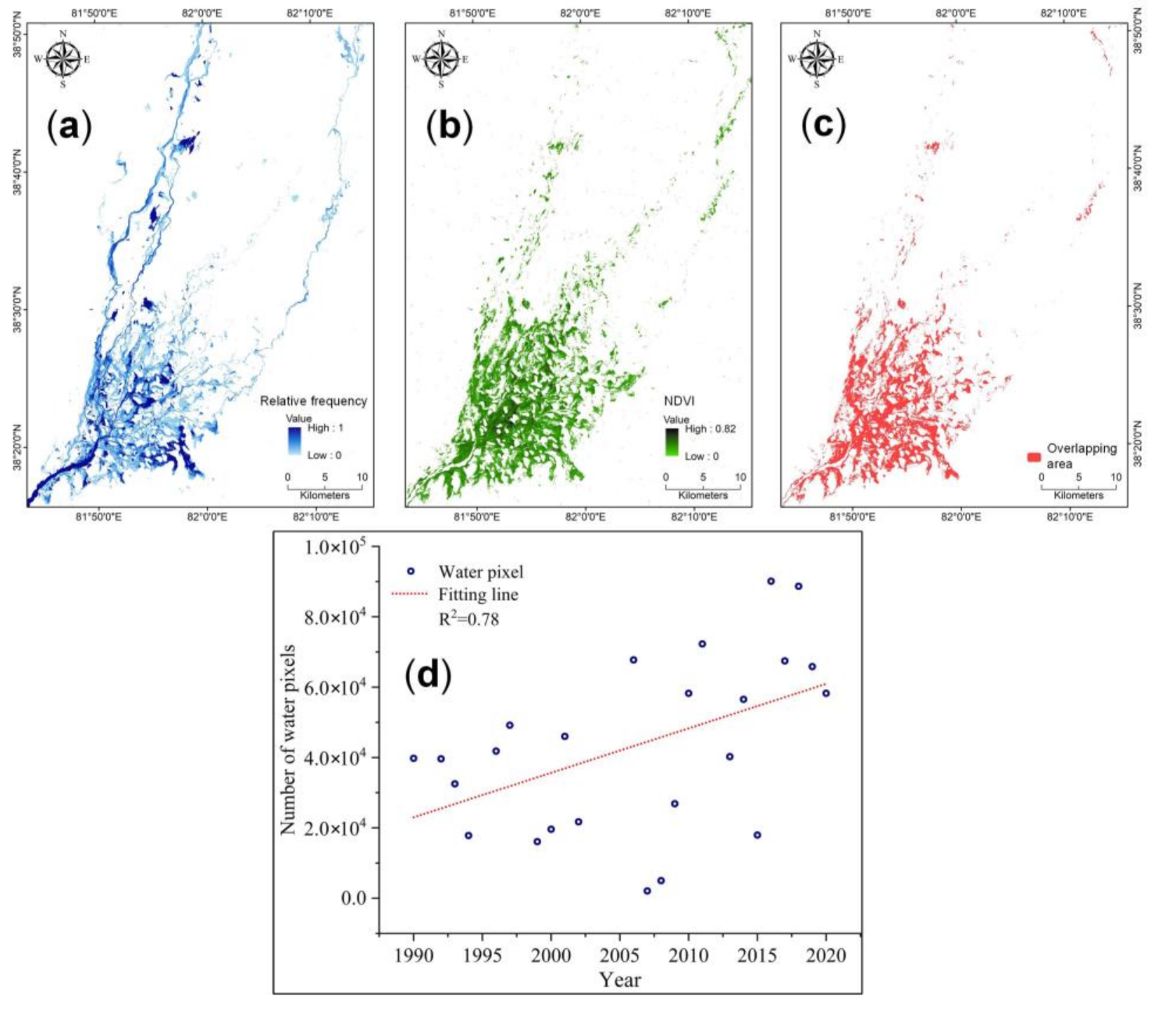

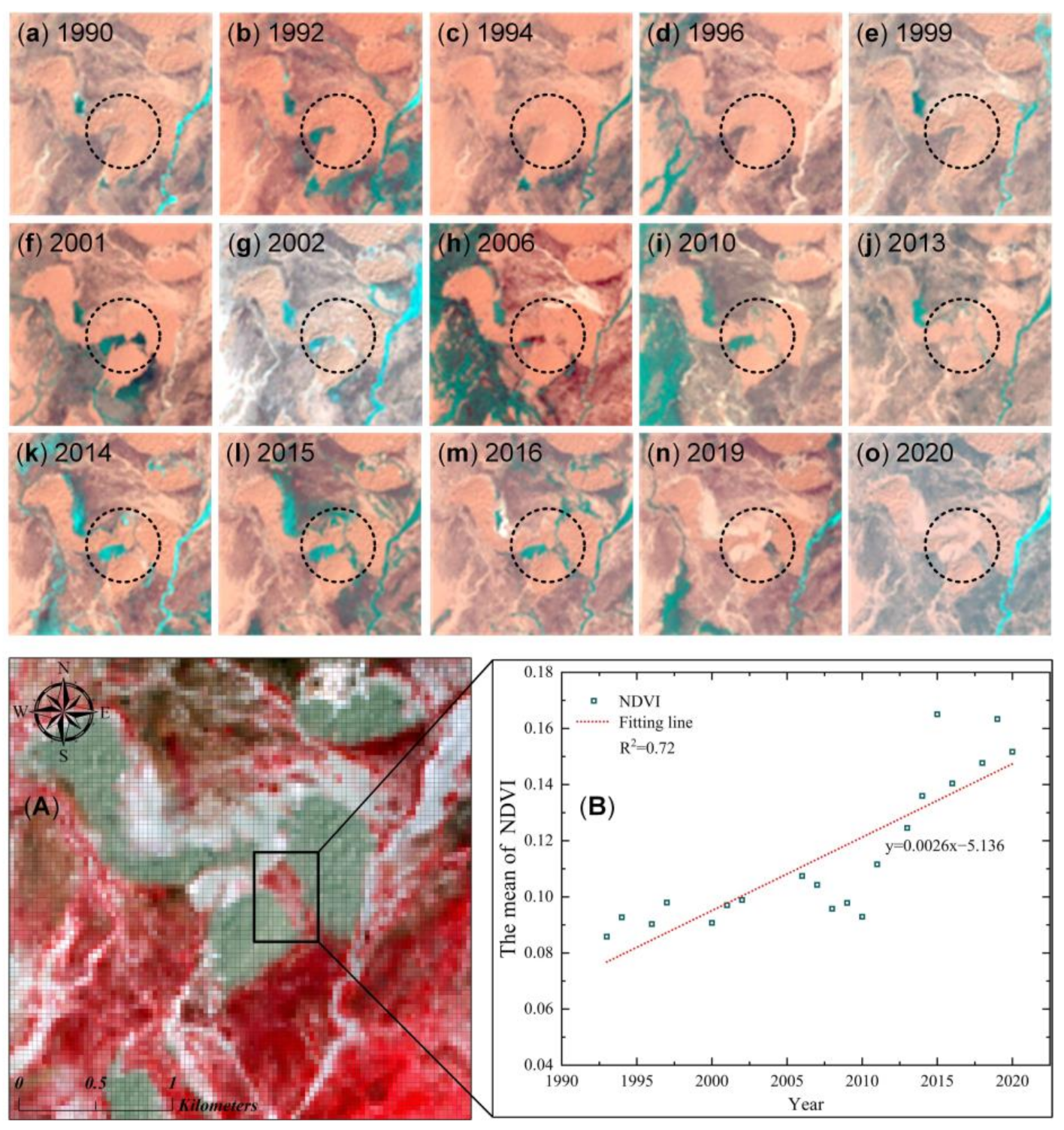
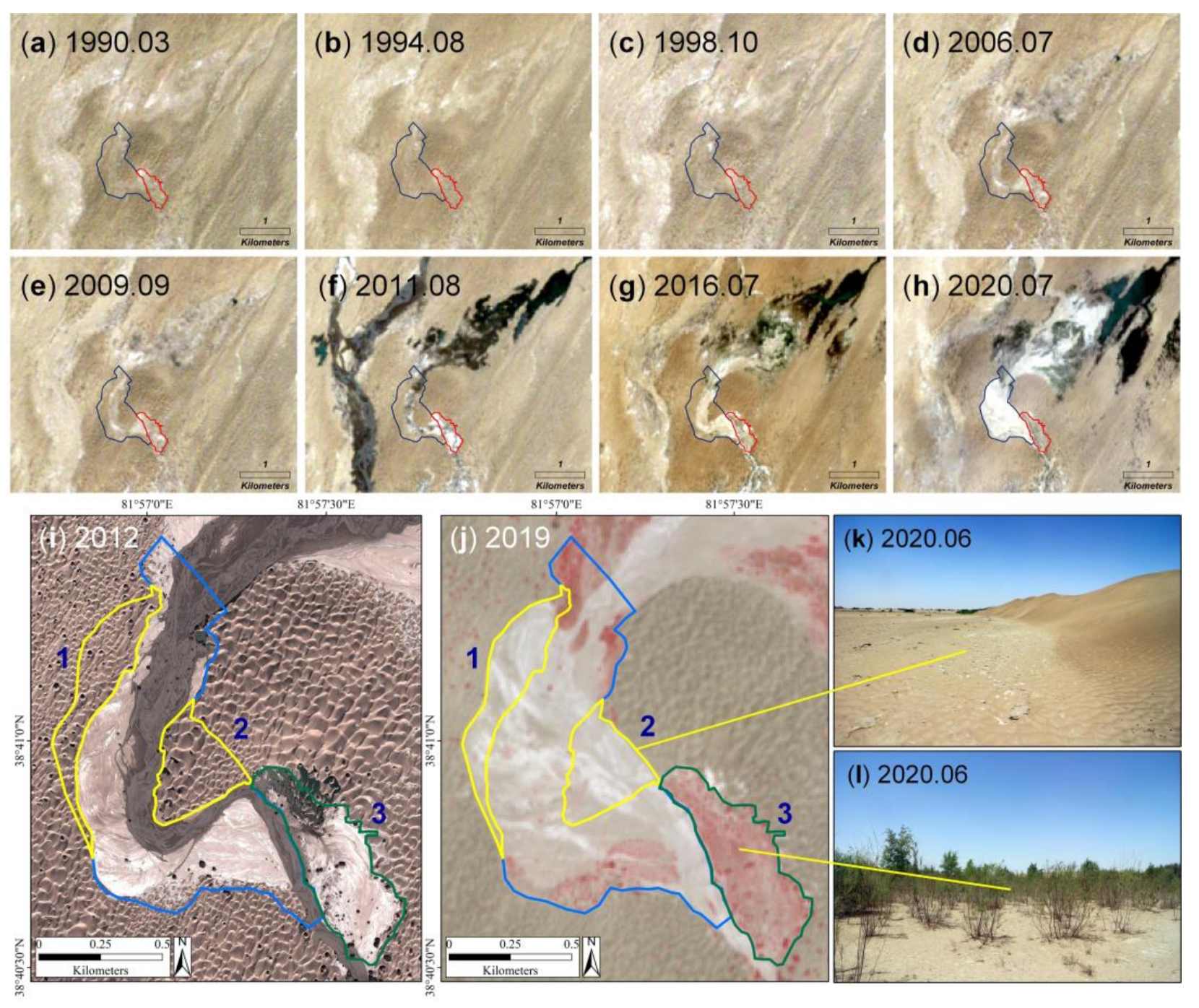

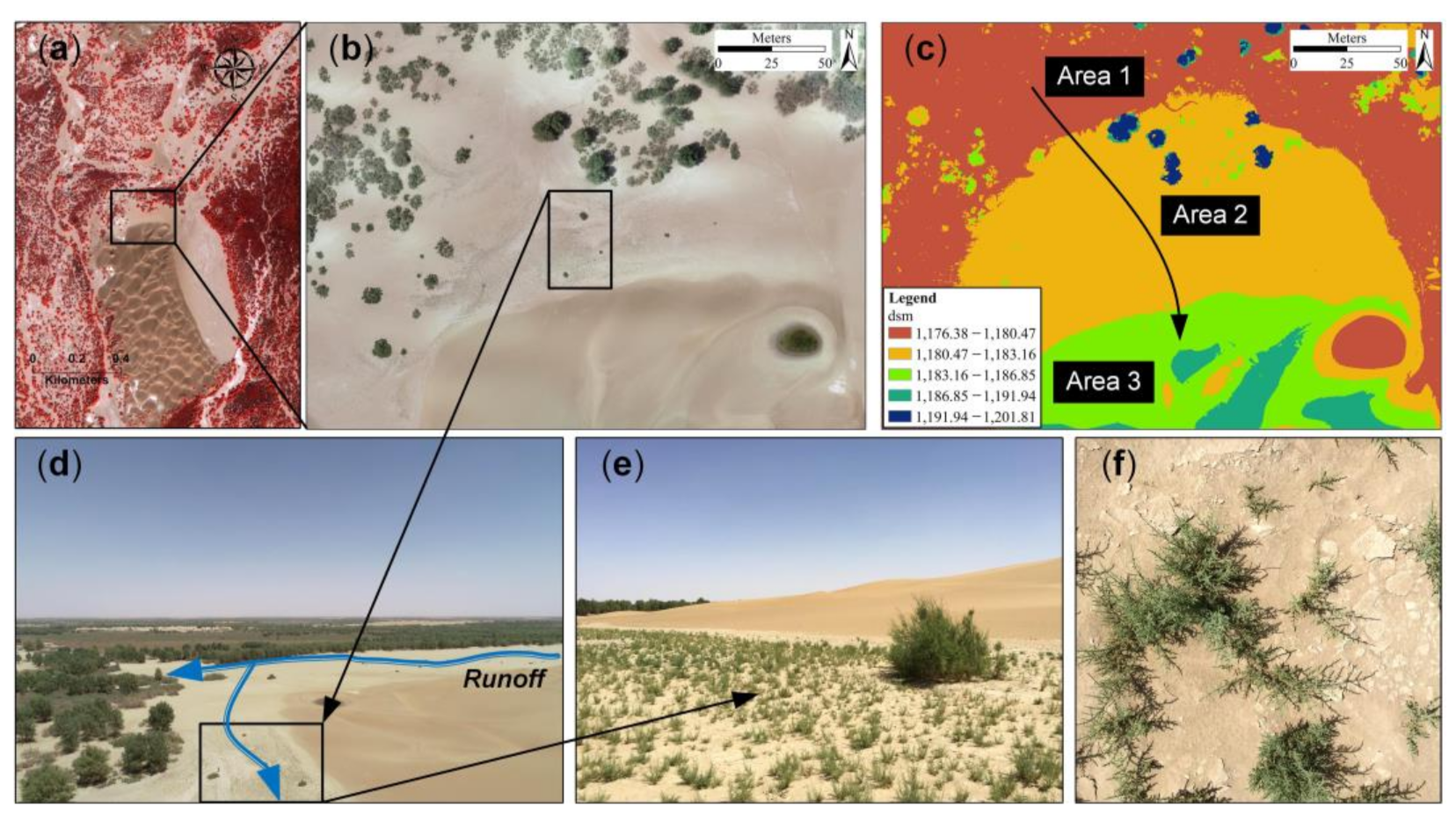
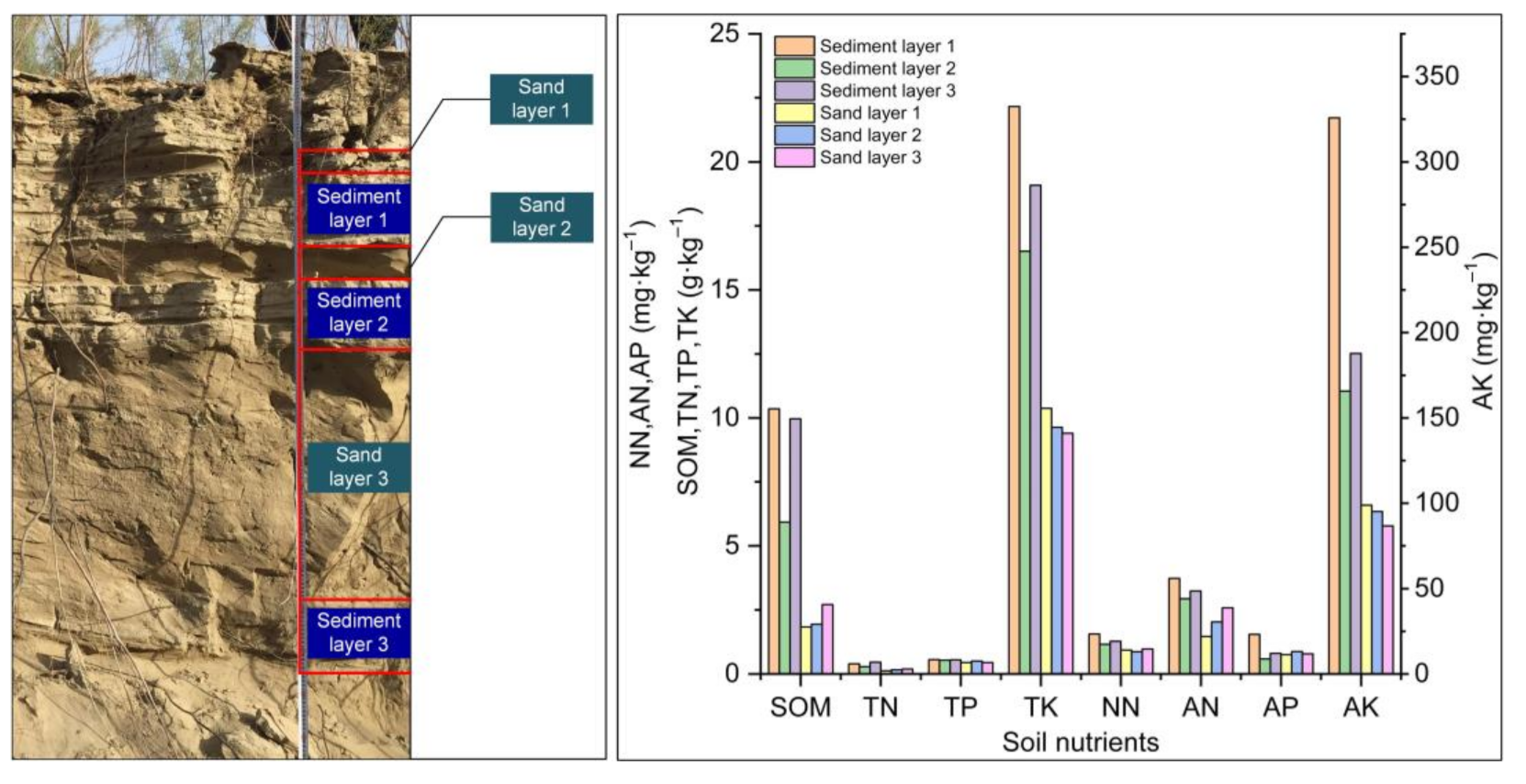
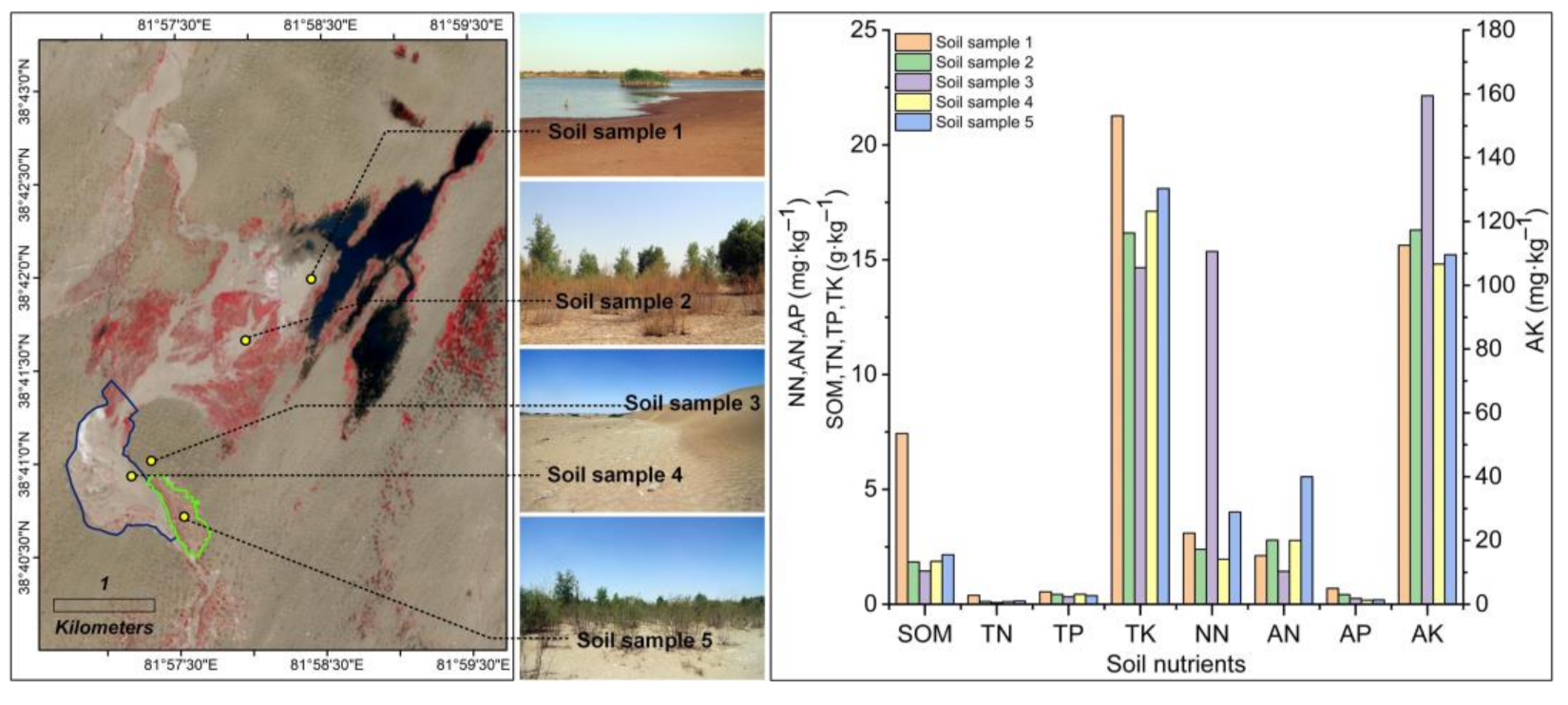
| Year | Sensor | Tiles |
|---|---|---|
| 1990–1998 | TM | 46 |
| 1999–2002 | ETM+ | 19 |
| 2006–2011 | TM | 46 |
| 2013–2020 | OLI | 79 |
| Classified Data | Reference Data | PA | |
|---|---|---|---|
| Water | Other | ||
| water | 86 | 7 | 92.47% |
| other | 15 | 392 | 96.31% |
| UA | 85.15% | 98.25% | |
| OA: 97% F1-score: 88.66% | |||
Publisher’s Note: MDPI stays neutral with regard to jurisdictional claims in published maps and institutional affiliations. |
© 2021 by the authors. Licensee MDPI, Basel, Switzerland. This article is an open access article distributed under the terms and conditions of the Creative Commons Attribution (CC BY) license (https://creativecommons.org/licenses/by/4.0/).
Share and Cite
Li, H.; Shi, Q.; Wan, Y.; Shi, H.; Imin, B. Influence of Surface Water on Desert Vegetation Expansion at the Landscape Scale: A Case Study of the Daliyabuyi Oasis, Taklamakan Desert. Sustainability 2021, 13, 9522. https://doi.org/10.3390/su13179522
Li H, Shi Q, Wan Y, Shi H, Imin B. Influence of Surface Water on Desert Vegetation Expansion at the Landscape Scale: A Case Study of the Daliyabuyi Oasis, Taklamakan Desert. Sustainability. 2021; 13(17):9522. https://doi.org/10.3390/su13179522
Chicago/Turabian StyleLi, Hao, Qingdong Shi, Yanbo Wan, Haobo Shi, and Bilal Imin. 2021. "Influence of Surface Water on Desert Vegetation Expansion at the Landscape Scale: A Case Study of the Daliyabuyi Oasis, Taklamakan Desert" Sustainability 13, no. 17: 9522. https://doi.org/10.3390/su13179522
APA StyleLi, H., Shi, Q., Wan, Y., Shi, H., & Imin, B. (2021). Influence of Surface Water on Desert Vegetation Expansion at the Landscape Scale: A Case Study of the Daliyabuyi Oasis, Taklamakan Desert. Sustainability, 13(17), 9522. https://doi.org/10.3390/su13179522






